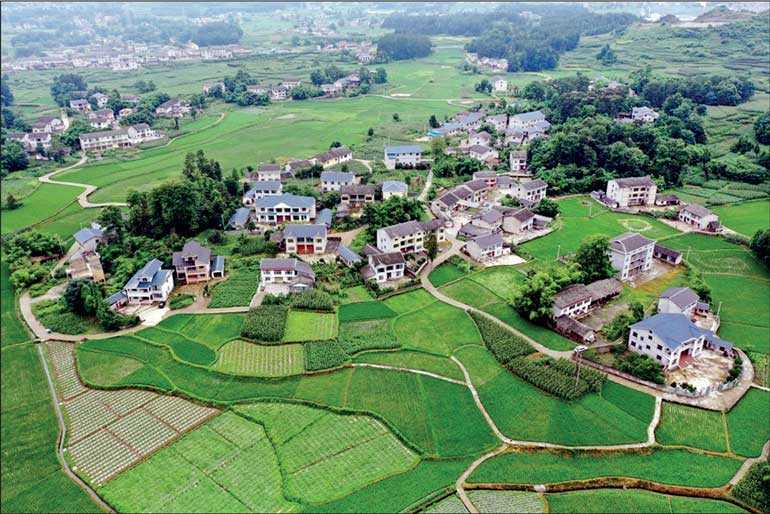Friday Apr 18, 2025
Friday Apr 18, 2025
Wednesday, 28 April 2021 00:00 - - {{hitsCtrl.values.hits}}

Aerial photo taken on 1 July 2020 shows a view of Fenghua Town of Suiyang County, southwest China’s Guizhou Province – Xinhua/Yang Ying
 In February, Chinese President Xi Jinping solemnly declared that China has secured a victory in its fight against poverty and the arduous task of eradicating extreme poverty has been accomplished. That means the largest developing country, home to nearly one-fifth of the world’s population, completes the first target of the UN 2030 Agenda for Sustainable Development 10 years ahead of schedule, which is an outstanding achievement in the history of humanity.
In February, Chinese President Xi Jinping solemnly declared that China has secured a victory in its fight against poverty and the arduous task of eradicating extreme poverty has been accomplished. That means the largest developing country, home to nearly one-fifth of the world’s population, completes the first target of the UN 2030 Agenda for Sustainable Development 10 years ahead of schedule, which is an outstanding achievement in the history of humanity.
President Gotabaya Rajapaksa, in his phone conversation with President Xi Jinping on 29 March, expressed a wish to learn governance experience from the Communist Party of China (CPC), strengthen exchanges and cooperation on poverty alleviation, and promote alignment of the ‘Gama Samaga Pilisandara’ (Dialogue with the Village) together with China’s ‘Targeted Poverty Alleviation’ and ‘Rural Vitalisation’ strategy.
The Government of Sri Lanka also has established two specialist Presidential Task Forces, on Economic Revival and Poverty Eradication, and for ‘Gama Samaga Pilisandara’ rural development. Poverty alleviation has become another important field of China-Sri Lanka cooperation.
What is the secret behind China’s victory in eliminating extreme poverty? I would like to bring your attention to the white paper “Poverty Alleviation: China’s Experience and Contribution” issued recently by China’s State Council Information Office and share some of China’s practices and experiences, in hope of contributing to Sri Lanka’s pursuit of reducing poverty.
China is the world’s largest developing country, with a population of 1.4 billion. In addition to its weak foundations and uneven development, the nation had long been plagued by poverty. From the middle of the 19th century, foreign aggression and the decadence of the imperial dynasty reduced China to a semi-colonial, semi-feudal society, and hundreds of millions of its people were plunged into poverty or even extreme poverty.
Poverty in China is at a scale and a level of severity that has rarely been seen anywhere else in the world. As a result, the challenge of poverty alleviation in China almost defies imagination. But the Chinese people have fought with fortitude to realise their dream – achieving economic prosperity, national rejuvenation, and a happy and better life.
Getting rid of poverty is not only an assiduous goal of Chinese people, but a solemn commitment made by the Communist Party of China. This year marks the 100th anniversary of the founding of the CPC. The CPC has taken the happiness of the people and rejuvenation of the nation as its aspiration since its founding.
Always regarding poverty alleviation as an important task for ensuring national peace and stability, the CPC has highlighted poverty alleviation at national level when setting its guidelines, principles and policies, and when formulating national plans for medium- and long-term development, and has pooled national resources to advance this cause. China’s historic poverty alleviation achievement is a result of strong and outstanding leadership of the CPC.
During the New Democratic Revolution period (1919-1949), the CPC led the people to launch the Agrarian Revolution to realise the goal of “the land to the tiller”, overthrew the rule of imperialism, feudalism, and bureaucrat-capitalism, and won victory in the New Democratic Revolution and established the People’s Republic of China in 1949, creating the political conditions it needed to eradicate poverty.
Since the founding of the PRC, the CPC led the people to complete the Socialist Revolution (1949-1956), establish the socialist system and promote socialist development. Under the leadership of the CPC, the Chinese people determined to rely on themselves and strived to build their homeland with strong determination and concerted effort, which laid solid foundation for the improvement of people’s living and poverty alleviation.
Since the Reform and Opening Up (1978), the CPC united and led the people to carry out a massive, planned, well-organised poverty alleviation effort at the national level, put forth efforts to liberate and boost the productive forces, to guarantee and improve people’s living, and made unprecedented achievements.
China marched into a new era after the 18th CPC National Congress in 2012. The CPC Central Committee with General Secretary Xi Jinping at the core, takes the desire of the people for a better life as its goal and takes poverty alleviation as a key task and index of the realisation of the First Centenary Goal.
The CPC set the goals that by 2020 it would help all the rural population out of poverty as defined by the existing standard, mobilising the whole Party, the whole country, and all sectors of society to engage in this battle. President Xi Jinping has always put poverty alleviation at the top of his work agenda, presented a series of important ideas and proposals, and made some major policy decisions.
During the past eight years, President Xi Jinping has assumed leadership, made plans, and directed the battle in person. He has visited every one of the 14 contiguous poor areas across the country and over 20 poor villages, and sat in the homes of impoverished households to hear of their difficulties, suggestions, and needs, building up their confidence and determination, and their belief that they can work their way out of poverty.
In 2020, faced with the sudden attack of COVID-19, Xi emphasised that lifting poor people in the rural areas out of poverty “must be achieved as scheduled” and asked the whole Party to apply more determination and more vigour, and to be confident of bringing the battle to a successful end.
Under the leadership of the CPC, China secured the final victory in the fight against extreme poverty. At the end of 2020, the 98.99 million people in rural areas who were living below the current poverty threshold all shook off poverty; all the 128,000 impoverished villages and 832 designated poor counties got rid of poverty. China has eliminated poverty over entire regions and eradicated extreme poverty. Those people have guarantees of adequate food and clothing, access to compulsory education, basic medical services, safe housing for impoverished rural residents, and safe drinking water.
Some 19.36 million impoverished people have been covered by rural subsistence allowances or extreme poverty relief funds. The systems for providing living allowances for poor people with disabilities and nursing subsidies for severely disabled persons cover more than 24 million. The poverty-stricken areas get rid of backwardness, with 1.1 million km of reconstructed highways and 35,000 km of new railways.
More remote areas are connected to power grids, and almost all rural areas enjoy a steady power supply. Over 98% of poor villages have access to optical fibre communications and 4G technology. A total of 25.68 million poor from 7.9 million households have had their dilapidated mud-and-straw cottages renovated. More than 9.6 million people have moved into new resettlement houses. Millions upon millions of children from poor families have fair access to education, and no longer need to walk cross mountains and river to their schools, being able to live and eat there.
Looking back, the past 100 years have witnessed the strenuous and difficult process whereby the CPC has led the Chinese people in the battle against poverty. The Party has committed itself to the original aspiration of seeking happiness for the people, taken on its responsibility for the people, honoured its promise to the people, and made huge sacrifices in fighting to win national independence and people’s liberation, to make China prosperous and strong, and to bring common prosperity to all. In the process it has won the support and trust of the people.
Under the leadership of the CPC, Chinese people have never faltered in pursuit of progress, have put in unimaginable efforts, and have relied on themselves to eradicate extreme poverty, and march towards shared all-round prosperity. Under the leadership of the CPC, China has stood tall, become prosperous, and grown in overall national strength. The protection of the rights to subsistence and development, and the promotion of equality and justice have laid solid foundations for well-rounded human development.
Looking forward to the future, China remains the world’s largest developing country, still confronted by the gap between unbalanced and inadequate development and the people’s growing desire for a better life, and by the gaps between urban and rural areas and between regions. China still has much to do in order to realise people’s all-round development and common prosperity for all.
Removing the label of extreme poverty is not the end, but the beginning of a new life and a new journey. The CPC will always put the people before everything else, and continue to work for people’s all-round development, and common prosperity and a better life for all. It will always remain committed to its founding mission, striving for the people’s wellbeing and the rejuvenation of the Chinese nation.

A rural doctor measures blood pressure for a villager of the Derung ethnic group at Bapo Village of Dulongjiang Township in Gongshan Derung and Nu Autonomous County, southwest China’s Yunnan Province, 26 October 2020 – Xinhua/Hu Chao

Villagers harvest fresh peppers at Qinggangba Village, Tangtou Township in Sinan County of southwest China’s Guizhou Province, 12 August 2020 – Xinhua/Yang Wenbin
The writer is the Ambassador of the People’s Republic of China in Sri Lanka.
Discover Kapruka, the leading online shopping platform in Sri Lanka, where you can conveniently send Gifts and Flowers to your loved ones for any event including Valentine ’s Day. Explore a wide range of popular Shopping Categories on Kapruka, including Toys, Groceries, Electronics, Birthday Cakes, Fruits, Chocolates, Flower Bouquets, Clothing, Watches, Lingerie, Gift Sets and Jewellery. Also if you’re interested in selling with Kapruka, Partner Central by Kapruka is the best solution to start with. Moreover, through Kapruka Global Shop, you can also enjoy the convenience of purchasing products from renowned platforms like Amazon and eBay and have them delivered to Sri Lanka.
Discover Kapruka, the leading online shopping platform in Sri Lanka, where you can conveniently send Gifts and Flowers to your loved ones for any event including Valentine ’s Day. Explore a wide range of popular Shopping Categories on Kapruka, including Toys, Groceries, Electronics, Birthday Cakes, Fruits, Chocolates, Flower Bouquets, Clothing, Watches, Lingerie, Gift Sets and Jewellery. Also if you’re interested in selling with Kapruka, Partner Central by Kapruka is the best solution to start with. Moreover, through Kapruka Global Shop, you can also enjoy the convenience of purchasing products from renowned platforms like Amazon and eBay and have them delivered to Sri Lanka.